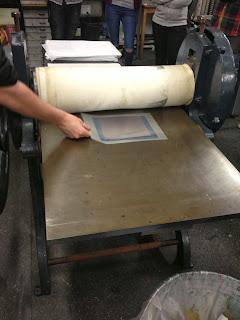At the start of the workshop today we were introduced to a variety of different samples that were on offer to illustrate to us the different ways we can emboss using different materials. We were told that whatever you emboss needs to be softer than what you actually emboss with.
There are two types of embossing which are illustrated on the photograph below. We can emboss or deboss. Embossing creates a relief effect where the actual design stands out from the paper, and deboss is where it is inwards.
We were also told that we can use card, MDF and metal but we were told to stay away from using flimsy card and to stick to mount board instead. Ideally if we use MDF it should be 1mm thick, essentially the thinner the better really. Obviously if we are wanting to do either of these processes we have to reverse our text for it to work. The team at Vernon Street are in charge of keeping an eye on our work during the 7 hours in which it is soaking in the solution.
Wood is better to deboss and metal is better to emboss. Using metal can however get quite costly, especially as a lot of the time it is a case of trial and error and we have to be prepared for if any mistakes are made.
To emboss here we need to print on frosted film and we can also get photographic images on metal plates too. We can't however use half tones when embossing and small typefaces aren't allowed. Sans serif are the most appropriate fonts to use as they turn out the best, however serif fonts can be used as long as they are bold enough. There are limitations with this process just as there are with most processes.
We were also shown an example of someone's work where they had tried to create brail using a copper plate and etching, however the detail was too small for it to work.
The key is to therefore use a font which is larger than 10pt and another tip we were made aware of was, if we are embossing business cards then we must lay them out in a grid to save time.
For an etching to hold ink it must be shallow otherwise the ink is wiped out of the plate during the process. One way around this however it to screenprint before embossing and this way a background colour can be created.
The first stage of the process is to sand the plate down as shown below.

We then have to pour degreaser on to it using and using colour coded sponge wipe away the excess. We then use newsprint to blot.
This is then what we are left with.
We then have to deal with the film. This film is light sensitive blue film and has 3 layers. The top layer is a clear laminate, the inside is frosted and then the third layer is the blue layer.
We then have to peel the frosted side off.
We then put acetate on top and then put the blanket over the top.
Before running it through we must ensure that the press is tight enough using the spanner.
We then roll it through, but we must make sure that at no point we touch the film because we could give it an anchor point and bubbles can form.
We then have to rotate it 90 degrees and run it back through the other way.
We then throw the acetate away and trim the excess with a knife around the edge.
This is what we are then left with.
Developing
To develop we use sodium carbonate and it is important that we use 10g to a litre of water. To start with we add enough water for it to dilute properly, and then we add cold water until it reaches the litre mark. The water ideally needs to be 18 degrees. We add three litres into the box which averages the salinity and temperature out.
We then took it to the UV light box where the positive ink needs to go in face down. Scotch tape it to the surface beforhand and place in the centre for 9 or 10 units, in this case he put it in for 7. Vacuum and then press start.
This is the random dot screen which we expose it to. It has a range of exposure. This process was developed for circuit boards originally.
We then remove the clear layer once it has been removed from the UV light box. Place in the water.
This is what it looks like when it comes out. The hotter the liquid the faster it will work. It is very liberal and can be overdeveloped (2 1/2 minutes). Sponge it every 30 seconds and it will get lighter and lighter until it looks like this.
Emboss
Put place on the newsprint and then put paper on top. Put tissue on top of this. Remove wooden boards if necessary then tighten screw on the side. Make sure the button is out then pump it all out until no further . Push button in then go again. The more pressure the better - midway on the gauge (330) undo the screw after.
Tape the copper down and trim. Hang it out over 7 hours. Then rotate it (the technicians do this). Etch at the top before the bottom which is why it needs to rotate.















































